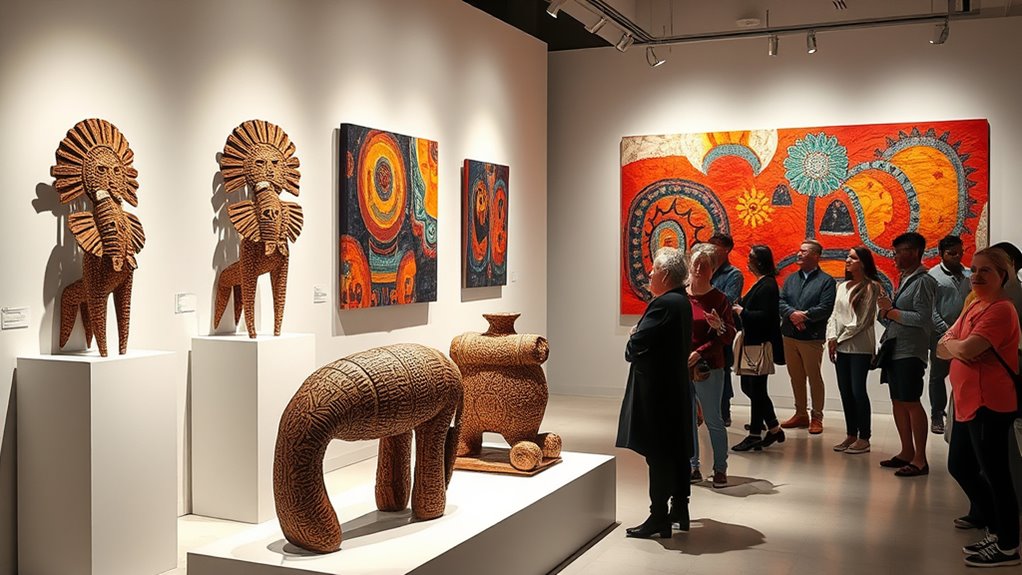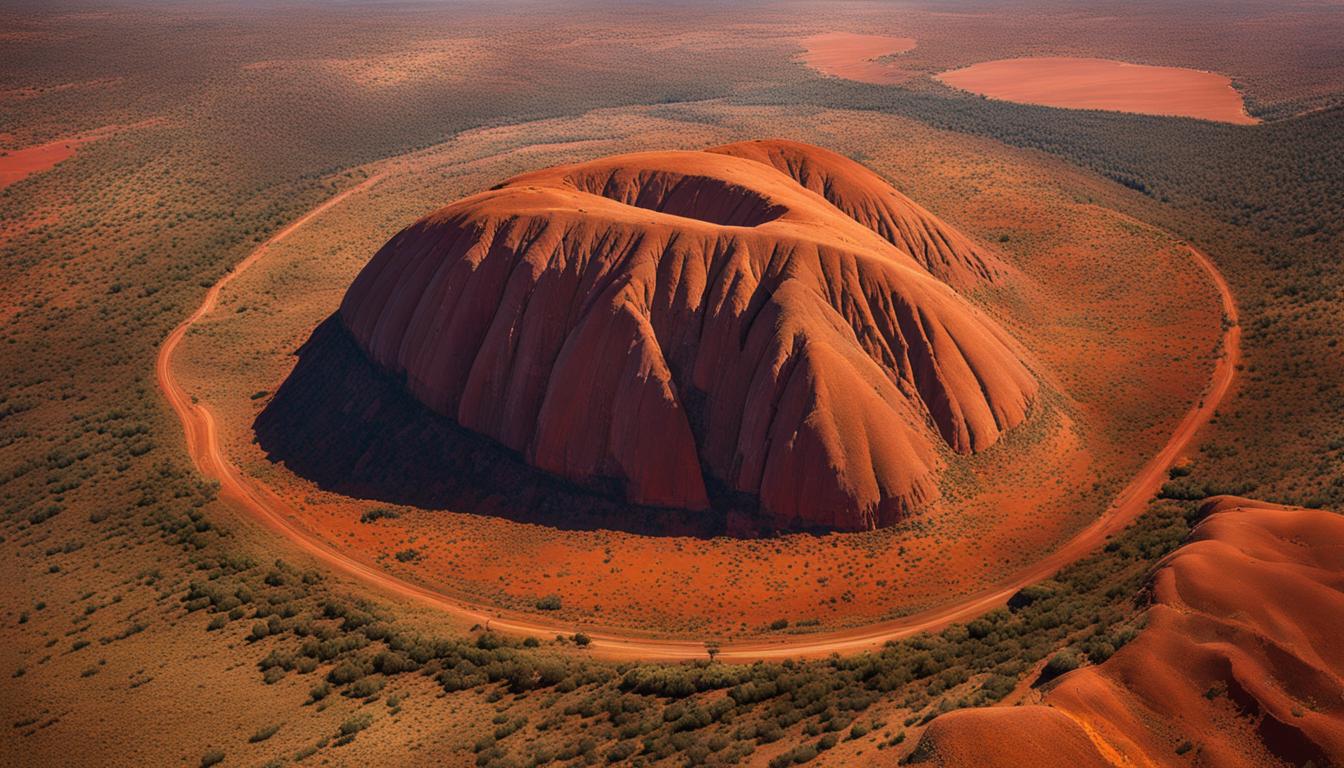Contemporary Indigenous art is actively transforming global galleries by blending cultural stories with innovative techniques that challenge stereotypes and highlight authentic voices. You’ll see this art gaining recognition for its boldness, layered meanings, and relevant social themes. Indigenous artists are moving beyond traditional forms, creating powerful works that speak to land rights, identity, and justice. Keep exploring, and you’ll discover how this vibrant movement continues to reshape the international art scene.
Key Takeaways
- Indigenous artists are gaining international recognition through innovative mediums that blend traditional motifs with contemporary techniques.
- Contemporary Indigenous art addresses global issues like land rights and social justice, resonating with diverse audiences.
- Galleries increasingly feature Indigenous works that emphasize cultural identity, layered symbolism, and bold artistic expression.
- Indigenous artists are transforming their cultural narratives to remain relevant and inspire future generations worldwide.
- The global art scene is elevating Indigenous voices, integrating authentic perspectives into major exhibitions and collections.

What exactly is contemporary Indigenous art? At its core, it’s a vibrant blend of cultural representation and artistic innovation. It’s a way for Indigenous artists to share their stories, traditions, and perspectives while pushing creative boundaries. Unlike traditional art forms, contemporary Indigenous art doesn’t just replicate old motifs; it reimagines them, infusing new meanings and techniques that resonate with today’s global audience. When you look at these works, you’re witnessing more than just aesthetic beauty—you’re engaging with a dialogue that bridges past and present, local and international. This art form acts as a powerful vessel for cultural expression, allowing Indigenous communities to assert their identities in a world that often seeks to erase or marginalize them. It’s about reclaiming narratives and challenging stereotypes through innovative mediums like mixed media, installation, digital art, and performance. The artists behind these creations aren’t confined by traditional boundaries—they’re exploring new ways to communicate their cultural stories, ensuring they remain relevant and dynamic. Additionally, the use of artistic innovation helps Indigenous artists to adapt their cultural narratives to a global context, making their work more accessible and impactful.
As contemporary Indigenous art continues to gain recognition, its role in global galleries becomes increasingly significant. These venues are embracing the richness of Indigenous perspectives, not just as exotic displays but as essential contributions to contemporary art dialogues. By doing so, galleries are acknowledging the importance of cultural representation—giving Indigenous artists a platform to share their experiences and challenge mainstream narratives. You see this happening across major international exhibitions, where works often stand out for their boldness and originality. These pieces often carry layered meanings, blending ancestral symbolism with modern techniques, creating a compelling fusion that appeals to diverse audiences. Artists are using their work to address pressing issues like land rights, environmental concerns, and social justice, making their art not only visually engaging but also politically charged. This fusion of activism and creativity elevates Indigenous art from local traditions to a global conversation.
The increasing visibility of Indigenous artists in prestigious galleries also encourages younger generations to see their culture as a living, evolving force. It inspires them to innovate while honoring their heritage. When you witness this movement, you realize it’s more than just art on display—it’s a crucial act of cultural resilience and a testament to the power of artistic innovation. Indigenous artists are no longer confined to the margins; they’re shaping the future of contemporary art and redefining how the world perceives Indigenous cultures. This ongoing surge of recognition proves that contemporary Indigenous art isn’t just conquering galleries—it’s transforming them, bringing fresh perspectives and authentic voices into the heart of global art scenes.
Frequently Asked Questions
How Do Indigenous Artists Navigate Cultural Representation in Global Galleries?
You navigate cultural representation by balancing authenticity with artistic sovereignty, ensuring your work reflects genuine traditions while expressing personal and contemporary perspectives. You maintain cultural authenticity by staying true to your roots, sharing stories and symbols responsibly. At the same time, you assert artistic sovereignty, making deliberate choices about how your work is presented and interpreted. This approach helps you honor your culture while engaging with global galleries confidently and respectfully.
What Challenges Do Indigenous Artists Face in Mainstream Art Markets?
Like steering a river with shifting currents, you face challenges in mainstream markets. You endeavor to maintain cultural authenticity while ensuring market accessibility, but commercial pressures often threaten your artistic integrity. The risk of misrepresentation or cultural appropriation looms, making it harder to share your work authentically. Despite these hurdles, you push forward, advocating for respect and genuine recognition in global galleries, bridging tradition and contemporary expression.
How Do Galleries Ensure Authentic Indigenous Storytelling?
You can guarantee authentic indigenous storytelling by engaging deeply with cultural preservation efforts and respecting traditional knowledge. Galleries collaborate with indigenous communities, allowing artists to share their stories in their own voices. They prioritize artistic authenticity, supporting projects that genuinely reflect indigenous perspectives. By fostering meaningful partnerships and safeguarding cultural heritage, galleries help maintain the integrity of indigenous narratives while showcasing their vibrant, diverse art to global audiences.
What Role Does Collaboration Play in Indigenous Art Exhibitions?
Collaboration in indigenous art exhibitions is like weaving a vibrant tapestry, blending diverse threads into a powerful story. You foster intercultural dialogue by working closely with indigenous communities, ensuring their voices lead the narrative. This partnership empowers communities, giving them control over their stories and representations. Through genuine collaboration, you create a space where indigenous art resonates authentically, enriching global galleries and strengthening cultural bonds with respect and shared understanding.
How Is Indigenous Art Influencing Contemporary Global Art Trends?
You see that indigenous art influences global trends by blending cultural preservation with artistic innovation. As you observe, artists incorporate traditional symbols and stories into modern mediums, creating fresh perspectives. This fusion not only celebrates indigenous identity but also pushes contemporary art forward. Your engagement with these works highlights how indigenous artists challenge conventions, inspire new styles, and shape a more inclusive, diverse global art scene that values both tradition and innovation.
Conclusion
Remember, beauty is in the eye of the beholder. As contemporary Indigenous art gains recognition in global galleries, it’s clear that these works aren’t just about aesthetics—they’re powerful stories and cultural expressions. By embracing these voices, you help break down stereotypes and celebrate diversity. Keep an open mind, because sometimes the most unexpected art teaches us the most. In this journey, you’re part of a movement that’s reshaping the art world—one piece at a time.
Mary is a passionate writer who brings creativity and a fresh perspective to our team. Her words have the power to captivate and inspire, making her an essential contributor to our content. Mary’s commitment to storytelling and dedication to promoting Indigenous culture ensures that her work touches the hearts of our readers. We’re fortunate to have her as part of our team.










